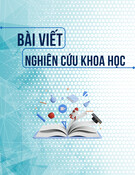
18 Dinh Le Minh Thong
KOREAN CULTURE SYMBOLS IN CHUNHYANG JEON
BIỂU TƯỢNG VĂN HOÁ KOREA TRONG TRUYỆN XUÂN HƯƠNG
Dinh Le Minh Thong*
University of Social Sciences and Humanities, Vietnam National University - Ho Chi Minh City, Vietnam
*Corresponding author: minhthong74nvc@gmail.com
(Received: February 28, 2025; Revised: March 21, 2025; Accepted: April 10, 2025)
DOI: 10.31130/ud-jst.2025.105
Abstract - Chunhyang Jeon is a famous novel of Korean literature
from the Joseon period around the 18th century. The work is a
collective creation (women), written in Hangul language, and is
the crystallization of the indigenous people's thoughts. Therefore,
Chunhyang Jeon a symbol of national culture. Thus far, Korea has
acknowledged and honored the story's imageries as part of its
cultural legacy by adapting them across a wide range of art forms.
The study analyzes images that have been cultivated by ancient
cultural memories to become Korean cultural symbols, such as the
model of women, the space containing the sediments of the times,
and the way of life in daily activities and beliefs as a model of
practice. Through that, the research wants to clarify the two major
functions of these cultural symbols: shaping the national cultural
identity and becoming a measure of valuation for contemporary
perceptions of human dignity.
Tóm tắt - Truyện Xuân Hương là cuốn tiểu thuyết trứ danh của
văn học Korea, vào thời Joseon (~XVIII). Tác phẩm là sáng tạo
tập thể (phụ nữ), được viết bằng chữ Hangul, là sự kết tinh tư
tưởng của con người bản địa. Vì thế, tự thân nó đã là một biểu
tượng của văn hoá quốc gia. Cho đến nay, các hình ảnh/hình
tượng trong truyện được đất nước Korea ngợi ca và thừa nhận là
di sản văn hoá, bằng sự gợi lại dưới nhiều hình thức biểu đạt khác
nhau. Bài viết đi vào phân tích các hình ảnh/ hình tượng được ký
ức văn hoá cổ xưa bồi đắp trở thành các biểu tượng văn hoá Korea
như hình mẫu người phụ nữ, không gian chứa đựng trầm tích thời
đại, nếp sống trong sinh hoạt - tín ngưỡng như một mẫu thực hành.
Qua đó, tác giả muốn làm rõ hai chức năng lớn của các biểu tượng
văn hoá ấy là việc định hình bản sắc văn hoá dân tộc và sự trở
thành thước đo định giá cho nhận thức của thời đương đại về
phẩm giá con người.
Key words - Chunhyang Jeon; Korean culture symbols; Seong
Chunghyang; landscapes; religions
Từ khóa - Truyện Xuân Hương; biểu tượng văn hoá Korea;
Thành Xuân Hương; cảnh quan; tôn giáo
1. Introduction
For over two centuries, Chunhyang Jeon has been
highly praised and celebrated. Numerous artistic products,
including music, painting, and especially cinema, have
adapted this aesthetically rich work into remarkable pieces
of art. In modern literature and cinema, many works have
reinterpreted the story with a “deconstructive” perspective.
Additionally, the lifestyle depicted in the story, as seen
through its characters, has become a model for many
contemporary Koreans to emulate in their self-cultivation.
What makes this work a national cultural heritage lies
in its accumulation of rich folk values, which are deeply
revered as the roots of Korean society. As a result,
Chunhyang Jeon has become a literary “monument” of
Korea, remembered as a cultural symbol. The novel, based
on pansori, is a written adaptation of Chunhyang-ga, which
originated from a shamanistic ritual in the mid-18th
century. The work was created by common Korean people
(primarily women) and was widely appreciated across all
societal strata in the past.
Through Chunhyang Jeon, readers can vividly observe
the context, people, and lifestyle of an era recounted in a
simple yet profound manner. It is a journey of constructing
belief, transforming what we see into cultural symbols of
Korea. By analyzing the imagery and figures in the story
through the lens of symbolic studies, it is evident that
representations of women, living spaces, and religious
practices have undergone a semantic shift, reaching a level
of abstraction. This contributes to shaping the national
cultural identity through literature while also
demonstrating how contemporary Korean life can trace its
roots back to the symbols within Chunhyang Jeon, serving
as “archetypes” of Korea “collective unconscious”.
2. Research Content
2.1. Seong Chunhyang: from legendary figure to the
archetype of Korean women
According to folklore, before becoming the renowned
protagonist of the novel, Chunhyang was an ordinary girl
with a lowly background, both in terms of appearance and
character. In ancient times, in the Namwon region,
Chunhyang was ostracized by the community and carried
her resentment (han) to her death, after which she became
a vengeful spirit that disturbed the people. To overcome the
endless trouble attributed to her, the community sought
redemption by worshiping her and retelling her biography.
From this point on, she was transformed into a flawless
young woman, receiving immense love and respect [1, pp.
69-70]. Recognizing the perfect woman embodied by
Chunhyang in her reconstructed legend, women in the
Joseon era, through their creative abilities, refined her
exceptional traits to establish an ideal model of Korean
womanhood. This model served as a standard for
evaluating women in society fairly. All these elements
were recorded in the pansori novel Chunhyang Jeon.
When discussing Chunhyang, one often feels a sense of
familiarity yet novelty, as she embodies both the shared
aesthetic of East Asia and the unique characteristics of

ISSN 1859-1531 - TẠP CHÍ KHOA HỌC VÀ CÔNG NGHỆ - ĐẠI HỌC ĐÀ NẴNG, VOL. 23, NO. 4, 2025 19
Korea. Like other talented women, Chunhyang was crafted
as an ideal beauty, embodying qualities of appearance
(mao 貌), talent (cai 才), emotion (qing 情), and intellect
(shi 识) [2]. According to popular summaries, she
possessed “the beauty of Zhang Jiang, the virtues of Ren
and Xu, the literary talent of Tai and Du, the gentle heart
of Tai Xu, and the fidelity of the two royal concubines (E
Huang and Nu Ying)…” [3, p. 27]. In the eyes of a scholar,
she was a perfect statue: “Her face reflected the white of a
crane in a blue river under the moonlight on snowy ground.
Her lips were rosy, and when she smiled, her teeth shone
like jade and stars... Her eyes were like the moon amidst
clouds; her lips, crimson like blooming lotuses in a pond”
[3, pp. 30-31]. Comparing to Confucian scholars,
Chunhyang also exhibited comparable intellectual beauty:
“At the age of seven or eight, she was already fond of
reading… Her mother was a kisaeng (courtesan), but she
was as knowledgeable as the daughters of noble families”
[3, pp. 17-27]. As a member of society, Chunhyang’s
cultivated talents were often perceived as serving the
purpose of entertaining the yangban (aristocracy), given
the societal accusations of her being a kisaeng. However,
considering her noble father’s lineage, her mother’s
decision to abandon the kisaeng life, and Chunhyang’s
self-awareness, she gained significant inner strength
through her intellect. Thus, Chunhyang also symbolizes an
educated woman. Although women’s education in Joseon
primarily emphasized moral virtues, such as being a filial
daughter, a virtuous wife, and a devoted mother [4, pp.
146-151], Chunhyang’s societal condition and self-
awareness contributed to affirming the intellectual
capabilities of women in the public sphere.
As a social citizen, Chunhyang, despite overcoming her
humble origins, stood up for kisaeng and, more broadly, for
all women. When coerced by the corrupt magistrate Byeon
Hak-do, Chunhyang questioned his authority: “- Is forcing
women a crime or not?” [3, p. 97]; “I will show you that
among kisaengs, there are also loyal and virtuous women.
Nong Xian, a courtesan in Hae Seo, died and was buried in
Dongxian Ling to preserve her fidelity; Sun Chun is listed
among the learned; Lun Jie of Jin Ju was posthumously
honored with a temple named Zhong Lie Men (Loyalty and
Valor Gate),… So, please do not look down on courtesans”
[3, p. 96]. Chunhyang’s actions highlight an essential
reality in the context of the Korean women’s movement,
which lacks a “we” (woori) spirit of solidarity among all
women. This has caused gender inequality to persist and
remain tense, as the contemporary women's community
itself is in conflict due to the overlapping of tradition and
modernity.
Living in the Joseon era, when Neo-Confucian moral
standards imposed more strict expectations on women,
Chunhyang exemplified the ideal family woman.
According to Confucianism, a woman was expected to
cultivate four aspects of femininity virtue, speech,
demeanor, and work before marriage [5, p. 106]. These
qualities were fully embodied in Chunhyang as she
entered her marriage with Mongryong. Furthermore,
Korean women were expected to rigorously learn and
practice the “feminine arts”, including virtues like
chastity, obedience, and humility [5, p. 109]. Faced with
Byeon Hak-do’s humiliation, Chunhyang remained
steadfast, resolutely preserving her fidelity while awaiting
Lee Mongryong: “- Fidelity belongs to one husband only;
no matter how much I’m beaten, my resolve will not
waver” [3, p. 99]. In order to achieve a happy ending with
a grand wedding, Chunhyang placed all her trust and
determination to protect her love against attitudes that
demeaned the female gender and the societal constraints
within the private sphere. For this reason, Chunhyang
became a symbol of love (Valentine’s Day). Later, the
Dano Festival was also associated with Chunhyang, as it
marked the day she first met Mongryong: “On that Dano
day, the weather was perfect… Chunhyang and her maid
Danhyang went out to play on the swings” [6], [3, p. 24].
Today, the city of Namwon is famously known as “The
City of Love”, thanks to the beautiful love story of
Chunhyang and her lover.
However, for the “New Woman” and “Modern Girl”
of today, Chunhyang does not represent a rigidly
traditional woman but rather a flexible individual who
created her own prominent style, transcending the
constraints of her era. She aligns with contemporary
feminist ideals of gender equality, particularly in romantic
relationships and marriage. This aspect of female
autonomy in private relationships reflects a continuation
of marriage practices from the Goryeo period and
resonates with the romantic, voluntary concept of love in
post-independence Korean society (1948~) [7, p. 28].
Chunhyang reinforced standards that belong to women,
earning her the title “Gentleman of Women” and being
posthumously honored by the Joseon king as “Zhen Lie
Furen” (Virtuous and Loyal Wife) [3, p. 153].
From a literary figure, Chunhyang has been reimagined
as a living woman through festivals. In popular culture,
creating cultural products requires a foundation of values
and beliefs to construct, project, and reinterpret icons,
heroes, stereotypes, and celebrities. Annually, during the
Namwon Chunhyang Festival, the Miss Chunhyang beauty
pageant crowns women who are not only beautiful but also
well-educated and well-mannered.
Figure 1. Chunhyang Shrine at Gwanghallu Garden (Namwon)

20 Dinh Le Minh Thong
Chunhyang is a relatable character and has been
adorned with many new identities because the public
continuously imagined and desired for a Chunhyang of
their own, expressed through diverse cultural forms. The
legendary figure of Chunhyang has become one of the
foundational values and beliefs that give rise to female
gender archetypes in various art forms, including poetry,
modern novels, music, theater, cinema, etc. Chunhyang
and her wonderful love story are the primary and most
influential source material for the birth and development of
Korean cinema in the early 21st century, with the most
successful example being the film Chunhyang (2000)
directed by Im Kwon-taek. Perhaps viewing Chunhyang as
a case of communal cultural consciousness, in order to
develop various creative interpretations of her in
contemporary art forms, is due to the Korean public not
only perceiving Chunhyang as being confined to the theme
of a lesson about female chastity, but also as an acceptance
and appreciation of her “secondary” yet broader aspects,
such as human liberation.
2.2. Housing and living landscapes: from physical
residences to the spiritual concept of harmony between
humans and nature
The entirety of Chunhyang Jeon takes place in
Namwon City, Jeolla Province, Korea. Through the story,
the people of Namwon recreated a portion of the Joseon
era, reflecting the lives of both the government and the
populace in this land. More importantly, this location gave
rise to a “cultured person” and fostered numerous beautiful
life choices associated with humanity.
Namwon is a naturally picturesque region, surrounded
by mountains and intersected by rivers, creating a close
connection between humans and nature: “In the blue sky,
swallows and other birds called to each other and flew in
pairs, appearing very affectionate. The north and south
were adorned with vibrant flowers. On the willow
branches, koikori birds sang to their mates. Trees formed
forests, and the cuckoos had flown away” [3, p. 18]. This
land was described as a place where “one could hear songs
praising peace and bountiful harvests,” where “the people
lived stable and joyful lives,” and where the governing
officials were virtuous individuals respected by the
populace. Thus, when the corrupt magistrate Byeon Hak-
do arrived, abusing his power, he faced rightful punishment
and the people’s resentment.
Namwon, now known as the “City of Love,” is
celebrated as the birthplace of the beautiful love story
between Chunhyang and Mongryong. Thus, every turning
point in the characters’ love journey is tied to a specific
landscape. The “meeting” phase between Chunhyang and
Mongryong is associated with Kwanghallu Pavilion,
amidst a bamboo forest with the scene of swinging (Geune
ttwigi). The “love” and “separation” phases are set within
the private space of Chunhyang’s room. The “loyalty”
phase takes place in the prison cell.
Kwanghallu Pavilion is a quintessential example of
Korean pavilion architecture. It belongs to the nugak style,
characterized by structures with only a foundation, pillars,
and a roof, lacking enclosing walls. These pavilions are
typically built on elevated terrain with scenic surroundings,
distinct from the nudae style, which features pavilions
constructed on earthen or stone platforms. Standing in a
nugak pavilion, one can fully admire the breathtaking
natural beauty that envelops the structure – a reflection of
humanity’s harmonious relationship with nature. In
Korea’s feudal society, gatherings to enjoy the scenery,
recite poetry, drink wine, and engage in similar leisure
activities on such pavilions were considered a cultural
indulgence of the aristocracy [8], [9]. In the story,
Gwanghallu Pavilion serves as the setting for Chunhyang
and Mongryong’s first meeting. Lee Mongryong paused
here, marveling at the scenery: “Under his gaze, the
landscape in all directions was truly magnificent… In this
direction, parrots and peacocks flew amidst blooming
white and pink flowers. The fragrant pine branches swayed
gently in the spring breeze. A waterfall cascaded into a
wide stream; along the stream’s banks, flowers smiled
brightly” [3, p. 22].
Figure 2. Kwanghallu Pavilion in Namwon, Korea
The intertwining design of landscapes and human
presence, as described above, reflects the pungbyu
aesthetic sensibility of classical Korean culture. Lee
Mongryong practiced this cultural essence within such
scenery through the refined pleasures of everyday life:
“Lee drank a cup of wine. Inspired by the wine’s effect, he
paced back and forth with a pipe in his mouth... The red,
green, pink, and white hues of the house, combined with
the song of the oriole, evoked the springtime spirit in him”
[3, p. 24]. From this interaction with nature, Mongryong
spotted Chunhyang in Dang Lim forest, where the beauty
of humanity and nature harmonized, accentuating each
other’s charm: “When she swung on the swing, her
beautiful legs were exposed, her figure floating amidst the
white clouds, her inner white dress and outer pink skirt
fluttering in the southeast wind. Her skin was as white as
gourd flesh; her entire body, at times hidden and at times
revealed among the white clouds, was clearly visible to
me” [3, p. 29].
In the literary tradition of “Caizi Jiaren” (talented
scholar-beautiful maiden) novels, authors often create
private spaces for couples to express their love and fulfill
their life-long promises. These private spaces are typically
the study rooms of young men or the boudoirs of talented
women. While Chunhyang Jeon reutilizes such traditional

ISSN 1859-1531 - TẠP CHÍ KHOA HỌC VÀ CÔNG NGHỆ - ĐẠI HỌC ĐÀ NẴNG, VOL. 23, NO. 4, 2025 21
spaces, it imbues them with deeper layers of meaning. In
this story, the private space is Chunhyang’s room - a setting
for many pivotal events involving the character. First and
foremost, the room reflects the personality and virtues of
its owner. In traditional Korean culture, the arrangement
and preparation of a home were often used to assess
women, as they were considered the primary caretakers of
the household. When Lee Mongryong visited Chunhyang’s
residence for the first time, he was astonished by the
elegance of her living quarters. The room not only
contained numerous feminine ornaments but also
displayed famous paintings and featured a poem written by
Chunhyang herself about preserving loyalty: “In front of
Chunhyang’s desk was a poem she had written about
maintaining fidelity” [3, p. 47]. It was in this very room
that Lee Mongryong pledged his love to Chunhyang. This
space became the setting for their physical and emotional
romantic adventure, as well as the witness to their tearful
separation.
The occupation of Chunhyang’s private room by the
two characters transcends traditional taboos and instead
focuses on the purity of pungbyu spirit, characteristic of
late Joseon aesthetics. This spirit emphasizes humanity's
inherent goodness, attention to the present, and the natural
emotions of individuals, their lives, and the societal
conflicts they face [10]. Folk authors utilized such private
spaces to express fertility beliefs (saengsik sinang),
embedding them within the narrative. In Chunhyang Jeon,
the depiction of nudity and the intimate connection
between the young couple vividly illustrates an intense
longing for love - a love that aspires to purity in body,
spirit, and intellect. The portrayal of their romance is
detailed and daring, rejecting the reserved and modest
aesthetic often associated with Eastern traditions.
Chunhyang and Mongryong's joyful union, in which time
seems to stand still, symbolizes a profound aspiration:
“Their unrestrained nudity, brimming with desire, becomes
a symbol of an ideal to be achieved” [11, p. 522]. This
aspiration aligns with the ideological world of their society
- a world of life and humanity unshackled from foreign
cultural constraints. The representation of human desire,
through the elevation of physical longing, also serves as a
means of preserving Korea’s cultural heritage. This
resonates with the nation’s strong sense of nationalism,
reflecting its commitment to safeguarding its unique
identity. Even today, in Korea, the preservation and
reverence for such beliefs remain evident through ritual
practices, daily activities, historical records, and literary
creations. These mediums continue to celebrate and uphold
the rich cultural legacy of fertility worship, offering
profound insights into the nation’s historical and cultural
consciousness.
In contrast to that beauty is the dark prison cell that
confined Chunhyang for resolutely rejecting the
magistrate. Folk writers of the past constructed these
opposing spatial symbols – “the room of love” and “the
prison” – as a subtle yet powerful condemnation of hostile
powers and the overreaching authority of the ruling class.
The “room of love” represents joy and the legitimate
aspirations of human life, while the “prison” embodies the
decay of a corrupt society, the filth of the ruling class,
contrasting sharply with the purity and resilience embodied
by Chunhyang. Her unwavering spirit amidst the darkness
highlights the triumph of human dignity and the enduring
beauty of enlightenment ideals over societal corruption.
The prison space is elevated to a symbol through the use of
exaggerated writing: “The prison door was broken. The
walls were rotting. Fleas biting people covered the dirt
floor” [3, p. 106]. The depiction of the prison, coupled with
Chunhyang’s steadfast endurance, transforms her into a
figure of universal admiration respected by both saints and
ordinary people alike.
To date, the Namwon region has evolved into a
prominent cultural site, characterized by vibrant festival
practices inspired by the legend of Chunhyang - a woman
renowned for her admirable love and virtue. Since the
construction of the Chunhyang Shrine in 1931, annual
traditional folk festivals have been organized, initially held
in early April according to the lunar calendar. However, the
festival was later rescheduled to coincide with the Duanwu
Festival (Dano) in May. Visitors to Namwon not only have
the opportunity to immerse themselves in the serene natural
landscape but also to relive a part of the nation's historical
legacy [6]. This historical immersion is facilitated through
the reenactment of Chunhyang Jeon using mannequin
displays - life-sized figures modeled after the portraits of
characters from the story. These mannequins are arranged
in alignment with character arcs and narrative scenes,
effectively recreating pivotal moments from the tale. This
reenactment incorporates an interactive dimension, akin to
the “role reversal” technique commonly employed in
theatrical performances. By assuming the roles of various
characters, visitors are afforded a unique opportunity to
engage deeply with the narrative, gaining insights into the
characters’ fates, roles, and gender dynamics. This
innovative approach not only enhances cultural
engagement but also serves as a mechanism for preserving
and promoting the historical and cultural values embedded
in the story.
From the vantage point of the Gwanghan Pavilion, one
can observe the vibrant spring activities of the villagers,
including the traditional Korean folk game of swinging,
which was vividly depicted by Chunhyang in her tale.
Swing riding, one of the most popular outdoor games for
young women, is traditionally played during the Duanwu
Festival. Chunhyang recreated the swinging scene during
the festival in the past [3, p. 24], and to make it easier to
visualize, the scene appears in the famous 2000 film
Chunhyang by director Im Kwon-taek or in the 18th-
century painting by artist Shin Yoon Bok (Figure 3). In
traditional Korean society, the Duanwu Festival, along
with recreational activities such as swing riding, provided
young women with a rare opportunity to experience
freedom and enjoy moments of self-expression, as their
daily lives were often constrained by household duties. For
these women, swing riding offered a thrilling sensation of
soaring into the air, symbolizing liberation. Interestingly,
some men also participated in this activity [12, p. 171]. The

22 Dinh Le Minh Thong
swing itself served as a symbol of love, with its rhythmic
back-and-forth motion through the supporting frame
carrying deeper connotations [7, p. 319]. Beyond the
physical, swing, the authors also incorporate other
symbolic imagery, such as the mortar and pestle, the
unextinguished flame, and more into the poetic lyrics and
songs, the story becomes refined, subtle, and civilized,
particularly during moments of dialogue and courtship
between characters. By employing these symbols as a form
of lyrical expression, the author emphasizes the yearning
for union, the hope for growth and vitality, and the
flourishing of all things born from youthful love. This core
humanitarian aspiration reflects the values of ordinary
people in the past, who sought to embed their desires and
dreams into a work that resonates with the spirit of their
era. The festival-like essence, from its literary creation to
its realization in real life, has been preserved and developed
by collective efforts. This continuity bridges the past and
the present, encouraging individuals to overcome
hesitations in dialogue and embrace a new mindset in
contemporary contexts. This is especially relevant in
addressing conflicts, particularly those arising from human
relationships, such as those between men and women.
Figure 3. “Dano Pungjeong” (
단오풍정
) – “Spring Festival
Scenery” by artist Shin Yoon-bok, 18th century
2.3. Religious practices: from metaphysical beliefs to a
source of liberation in the secular world
In Korean religious beliefs, while Buddhism and
Confucianism are often associated with imposing
significant restrictions and disadvantages on women,
Shamanism serves as a sanctuary for women. Within this
spiritual domain, each individual is endowed with divine
power and authority, enabling them to harness their
strengths and potential. As such, Chunhyang Jeon, as a
work created by and about women, incorporates elements
of indigenous Shamanistic culture to express human
desires within the constraints of a Confucian society.
In the Korean worldview, the supernatural forces that
govern the world have never disappeared. The reason
Shamanism endured and continued to support people
during the harsh Joseon era is because it provided practical
benefits in human life, namely peace and happiness [13].
Chunhyang Jeon employs numerous Shamanistic elements
because it represents a spiritual and religious ideology that
is inherently fair, unaligned with any political power, and
solely attuned to human emotions and desires.
First, through the spiritual element of the gut ceremony,
Chunhyang transforms from an unattractive, ostracized girl
into a woman desired by many of her peers. And it is also
thanks to the spiritual cultural customs of ancient Korean
people that Chunhyang is once again reborn into the human
realm. In Chunhyang Jeon, Chunhyang was originally a
child conceived through prayer. The courtesan Wol-mae,
despite being over 40 years old and unable to bear children,
reflected on ancient methods of conception, then advised
her husband, and together they “bathed thoroughly and
sought a place to pray” [3, p. 15]. In earlier times, to
conceive a child, people would often visit temples or
famous mountains to sincerely perform ceremonies
requesting a child, evoking the worship culture of Samsin
halmeoni (the goddess of childbirth and fate). After
examining the landscape, the couple decided to choose Ban
Ya Peak, where they erected an altar and arranged
offerings. Indeed, at midnight on the Dano Festival day,
Wol-mae had a dream and subsequently gave birth to a
beautiful daughter named Seong Chunhyang. This
inexplicable miracle contributed to the iconography of this
exceptionally beautiful woman, a character born through
supernatural forces. Therefore, Seong Chunhyang’s
identity and status are quite unique, unlike many female
characters in the East Asian “scholar-beauty” narrative
tradition. The deification of Chunhyang's origin is the key
that allows her to overcome society's prejudicial views.
Without divine intervention, many events such as the
meeting and engagement of Chunhyang and Mongryong
would have been difficult to realize. Their love was
heaven-ordained: “Dreams are not unreal. Last night,
mother dreamed of a dragon in the Bi Tao Chi (Jade Peach
Pond). This must be an auspicious sign, so today's events
are not coincidental. And mother heard that the
magistrate’s son is named Mongryong. ‘Mong’ means
dream; ‘Ryong’ means dragon, so it matches perfectly” [3,
p. 30]. By invoking supernatural forces through “dreams”,
Chunhyang and other characters in the story were able to
save themselves from moral transgressions.
Chunhyang Jeon extensively exploits the mystical
elements of Shamanism through characters entering
the dream realm. “Dreams” have historically created
pathways to celestial realms and the underworld, becoming
a motif in creative techniques; allowing “the
disempowered” to express themselves, and more
significantly, to actualize deeply suppressed desires. By
incorporating folklore materials into their creations, folk
artists have transformed dreams into beliefs that redeem the
human soul. In the darkness of night, within the desolate
prison, Chunhyang journeys into sleep. There, she
encounters immortals who were once renowned talented
women. They express their sympathies regarding
Chunhyang’s unjust situation and praise the radiant
qualities of a woman wrongfully labeled as a courtesan.
In her imprisonment, exhausted from weeping and
resentment, Chunhyang sinks into a dream where she
ascends to paradise to meet celestial maidens, reuniting

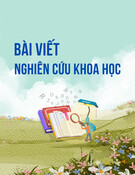
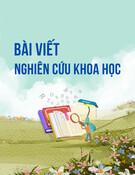
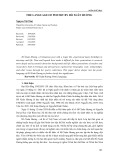



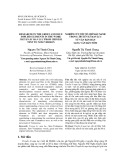


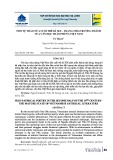
![Bộ câu hỏi trắc nghiệm Văn bản tiếng Việt [chuẩn nhất]](https://cdn.tailieu.vn/images/document/thumbnail/2025/20251127/thuynhung051106@gmail.com/135x160/24021764296609.jpg)
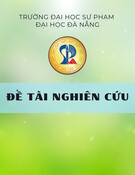

![Bài giảng Ngôn ngữ học đối chiếu Nguyễn Ngọc Chinh [PDF]](https://cdn.tailieu.vn/images/document/thumbnail/2025/20251101/vovu03/135x160/7471762139652.jpg)

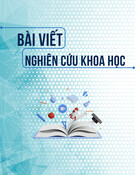
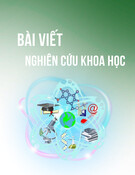

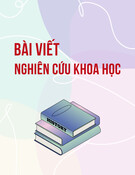
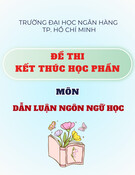

![Ngân hàng câu hỏi môn Tiếng Việt thực hành [chuẩn nhất]](https://cdn.tailieu.vn/images/document/thumbnail/2025/20251003/kimphuong1001/135x160/21861759464951.jpg)
![Bài giảng Văn học phương Tây và Mỹ Latinh [Tập hợp]](https://cdn.tailieu.vn/images/document/thumbnail/2025/20251003/kimphuong1001/135x160/31341759476045.jpg)

